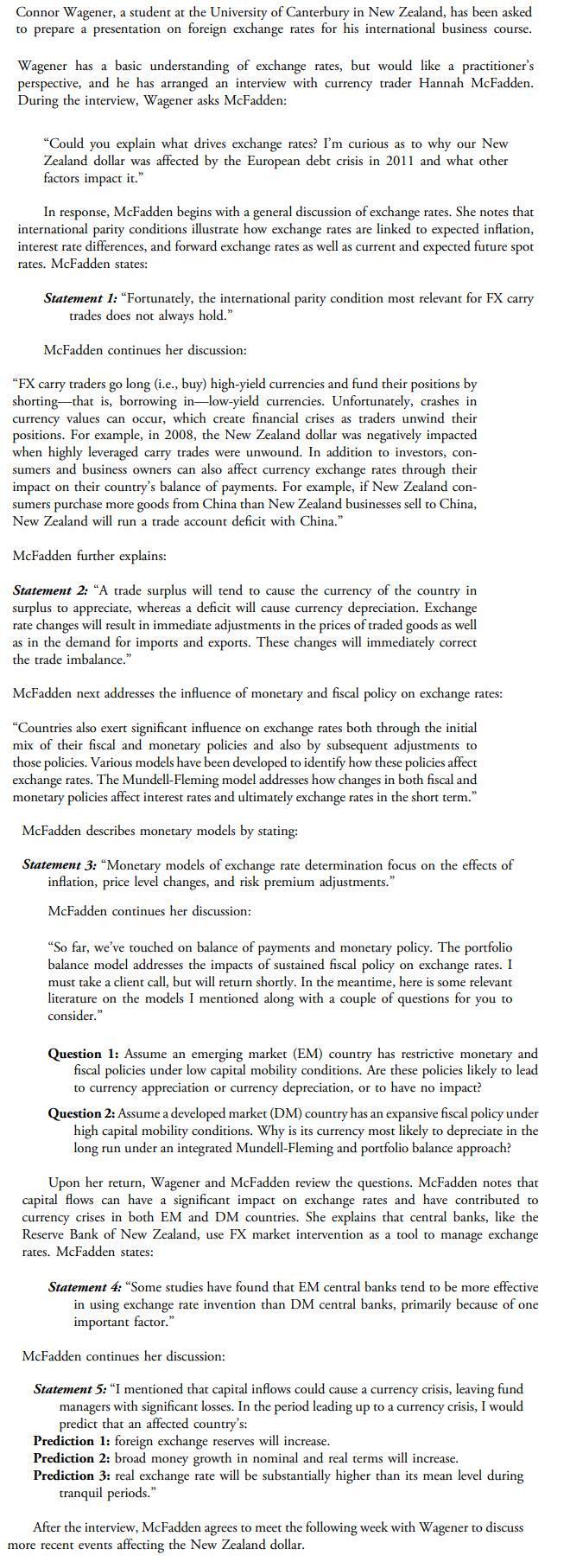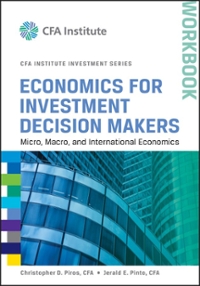The factor that McFadden is most likely referring to in Statement 4 is: A. FX reserve levels.
Question:
The factor that McFadden is most likely referring to in Statement 4 is:
A. FX reserve levels.
B. domestic demand.
C. the level of capital flows.

Transcribed Image Text:
Connor Wagener, a student at the University of Canterbury in New Zealand, has been asked to prepare a presentation on foreign exchange rates for his international business course. Wagener has a basic understanding of exchange rates, but would like a practitioner's perspective, and he has arranged an interview with currency trader Hannah McFadden. During the interview, Wagener asks McFadden: "Could you explain what drives exchange rates? I'm curious as to why our New Zealand dollar was affected by the European debt crisis in 2011 and what other factors impact it." In response, McFadden begins with a general discussion of exchange rates. She notes that international parity conditions illustrate how exchange rates are linked to expected inflation, interest rate differences, and forward exchange rates as well as current and expected future spot rates. McFadden states: Statement 1: "Fortunately, the international parity condition most relevant for FX carry trades does not always hold." McFadden continues her discussion: "FX carry traders go long (i.e., buy) high-yield currencies and fund their positions by shorting that is, borrowing in-low-yield currencies. Unfortunately, crashes in currency values can occur, which create financial crises as traders unwind their positions. For example, in 2008, the New Zealand dollar was negatively impacted when highly leveraged carry trades were unwound. In addition to investors, con- sumers and business owners can also affect currency exchange rates through their impact on their country's balance of payments. For example, if New Zealand con- sumers purchase more goods from China than New Zealand businesses sell to China, New Zealand will run a trade account deficit with China." McFadden further explains: Statement 2: "A trade surplus will tend to cause the currency of the country in surplus to appreciate, whereas a deficit will cause currency depreciation. Exchange rate changes will result in immediate adjustments in the prices of traded goods as well as in the demand for imports and exports. These changes will immediately correct the trade imbalance." McFadden next addresses the influence of monetary and fiscal policy on exchange rates: "Countries also exert significant influence on exchange rates both through the initial mix of their fiscal and monetary policies and also by subsequent adjustments to those policies. Various models have been developed to identify how these policies affect exchange rates. The Mundell-Fleming model addresses how changes in both fiscal and monetary policies affect interest rates and ultimately exchange rates in the short term." McFadden describes monetary models by stating: Statement 3: "Monetary models of exchange rate determination focus on the effects of inflation, price level changes, and risk premium adjustments." McFadden continues her discussion: "So far, we've touched on balance of payments and monetary policy. The portfolio balance model addresses the impacts of sustained fiscal policy on exchange rates. I must take a client call, but will return shortly. In the meantime, here is some relevant literature on the models I mentioned along with a couple of questions for you to consider." Question 1: Assume an emerging market (EM) country has restrictive monetary and fiscal policies under low capital mobility conditions. Are these policies likely to lead to currency appreciation or currency depreciation, or to have no impact? Question 2: Assume a developed market (DM) country has an expansive fiscal policy under high capital mobility conditions. Why is its currency most likely to depreciate in the long run under an integrated Mundell-Fleming and portfolio balance approach? Upon her return, Wagener and McFadden review the questions. McFadden notes that capital flows can have a significant impact on exchange rates and have contributed to currency crises in both EM and DM countries. She explains that central banks, like the Reserve Bank of New Zealand, use FX market intervention as a tool to manage exchange rates. McFadden states: Statement 4: "Some studies have found that EM central banks tend to be more effective in using exchange rate invention than DM central banks, primarily because of one important factor." McFadden continues her discussion: Statement 5: "I mentioned that capital inflows could cause a currency crisis, leaving fund managers with significant losses. In the period leading up to a currency crisis, I would predict that an affected country's: Prediction 1: foreign exchange reserves will increase. Prediction 2: broad money growth in nominal and real terms will increase. Prediction 3: real exchange rate will be substantially higher than its mean level during tranquil periods." After the interview, McFadden agrees to meet the following week with Wagener to discuss more recent events affecting the New Zealand dollar.
Fantastic news! We've Found the answer you've been seeking!
Step by Step Answer:
Answer rating: 50% (4 reviews)

Answered By

Hamza Amjad
Currently I am student in master degree program.from last two year I am tutring in Academy and I tought many O/A level student in home tution.
4.80+
3+ Reviews
10+ Question Solved
Related Book For 

Economics For Investment Decision Makers
ISBN: 9781118111963
1st Edition
Authors: Sandeep Singh, Christopher D Piros, Jerald E Pinto
Question Posted:
Students also viewed these Business questions
-
In Statement 2, McFadden is most likely failing to consider: A. the initial gap between the country's imports and exports. B. the price elasticity of export demand versus import demand. C. the lag in...
-
The international parity condition McFadden is referring to in Statement 1 is: A. purchasing power parity. B. covered interest rate parity. C. uncovered interest rate parity. Connor Wagener, a...
-
The least appropriate factor used to describe the type of models mentioned in Statement 3 is: A. inflation. B. price level changes. C. risk premium adjustments. Connor Wagener, a student at the...
-
Alpha corp reports the following results for the current year: net income per books (before federal income taxes ) 738,000 federal income tax expense per books (156,240) net income per books (after...
-
(a) How much work is required to accelerate a proton from rest up to a speed of 0.985c? (b) What would be the momentum of this proton?
-
Generate the full set of clauses for the map-coloring graph in Figure 8.1. Resolve these clauses to prove that a three-coloring solution does exist for the graph. data from figure 8.1 A B C D
-
Explain the difference between the one-tailed and two-tailed versions of the Wilcoxon rank sum test for independent random samples.
-
Refer to Exercise 6-4. Using the same figures, assume that the merchandise mentioned was included in Pearces inventory, having been purchased from Searl. Required: Calculate the controlling interest...
-
Which is more important--understanding the legal description (physical measurement of the land) or understanding the economic characteristics of the land? Or is it equally important to have a clear...
-
Which of McFadden's predictions in Statement 5 is least correct? A. Prediction 1 B. Prediction 2 C. Prediction 3 Connor Wagener, a student at the University of Canterbury in New Zealand, has been...
-
The most likely response to Question 2 is a(n): A. increase in the price level. B. decrease in risk premiums. C. increase in government debt. Connor Wagener, a student at the University of Canterbury...
-
Name and describe three different forms of business organization.
-
X Calculate the reaction rate at various conversions, as shown below: FAO -TA -TA 0.2 0.8 Considering that for a PFR: dx V = FAO What is the conversion reached after the 50 m of this PFR?
-
For decades, leaders have talked about flexible working options, yet only few companies were consistently using these practices prior to the global health crisis of 2020. In March 2020, organizations...
-
Manatee Corp. has developed standard costs based on a predicted operating level of 352,000 units of production, which is 80% of capacity. Variable overhead is $281,600 at this level of activity, or...
-
When leaders are facing a crisis or an opportunity, generally, they tend to fall back on the leadership style that has worked for them in the past. Discuss with examples the options that would help...
-
Data Table the pasteet dollar -X Total sales revenues 2 Number of units produced and sold 500,000 units Selling price nt. $ 230,000 te Operating Income Total Investment in assets Variable cost per...
-
You are the information systems director for Abbon Laboratories, a biotechnology research firm with about 100 employees. Alice Stampler, Abbons president, is aware that Abbons incoming e-mail...
-
You are standing at x = 9.0 km and your assistant is standing at x = 3.0 km. Lightning bolt 1 strikes at x = 0 km and lightning bolt 2 strikes at x = 12.0 km. You see the flash from bolt 2 at t = 10...
-
What is the incidence of an excise tax when demand is highly inelastic? Highly elastic? What effect does the elasticity of supply have on the incidence of an excise tax? What is the efficiency loss...
-
Suppose the equation for the demand curve for some product X is P = 8 .6Q and the supply curve is P = 2 + .4Q. What are the equilibrium price and quantity? Now suppose an excise tax is imposed on X...
-
Both antitrust policy and industrial regulation deal with monopoly. What distinguishes the two approaches? How does government decide to use one form of remedy rather than the other?
-
Accounting changes fall into one of three categories. Identify and explain these categories and give an example of each one.
-
Machinery is purchased on May 15, 2015 for $120,000 with a $10,000 salvage value and a five year life. The half year convention is followed. What method of depreciation will give the highest amount...
-
Flint Corporation was organized on January 1, 2020. It is authorized to issue 14,000 shares of 8%, $100 par value preferred stock, and 514,000 shares of no-par common stock with a stated value of $2...

Study smarter with the SolutionInn App


